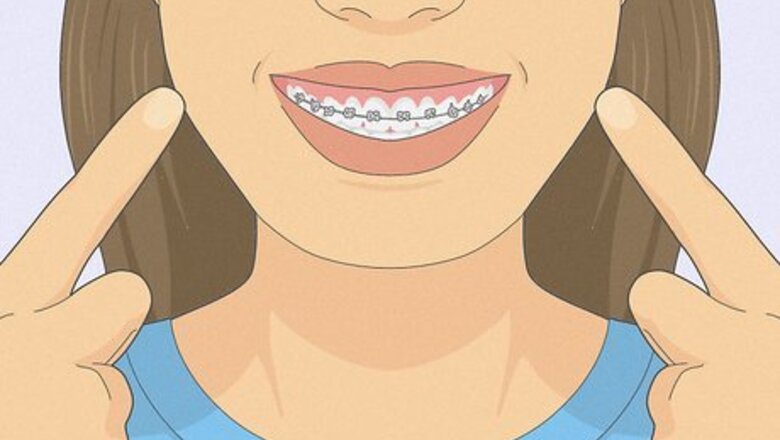
views
Practicing Your Smile
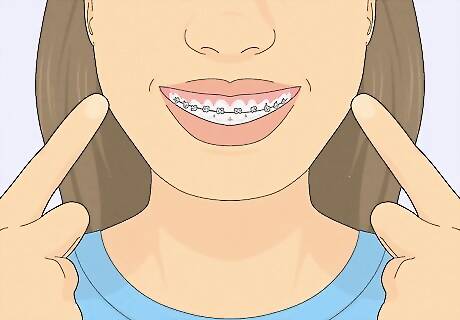
Exercise your smile. The best way to grow comfortable with smiling while wearing braces is to practice. Your facial expressions rely on a series of muscles in your face, so "exercising" your smile in front of a mirror can help you find a smile range that you're comfortable with. Stretch the corners of your mouth outward, keeping your lips closed. Hold that pose for 10 seconds, then release it. Repeat the first stretch, but part your lips just enough to expose the line where your top row of teeth meets the bottom row of teeth. Hold that pose for 10 seconds, then release it. Stretch the corners of your mouth even farther outward until your lips part enough to expose roughly half of your teeth. Hold that pose for 10 seconds, then release it. Stretch the corners of your mouth as wide as you can, exposing all of your teeth. Hold that pose for 10 seconds, then release it. Practice these stretches in front of a mirror until you find a smile you're comfortable with, and continue to exercise your facial muscles until you have total control over your smile.

Develop a more natural smile. Once you've started exercising your facial muscles, the next step is to develop a more natural, comfortable-looking smile that won't look forced. One way to do this is to tone additional facial muscles. Purse your lips, making them as big as possible while pulling in your cheeks. While keeping your lips pursed, try to simultaneously stretch the corners of your mouth outward, into a smile. Hold that pose just long enough that your facial muscles begin to feel fatigued. Then release it. Do not practice this exercise more than once a day, as excessive stretching may cause muscle strain. Over time, this stretch should help your smile look more natural and more radiant.
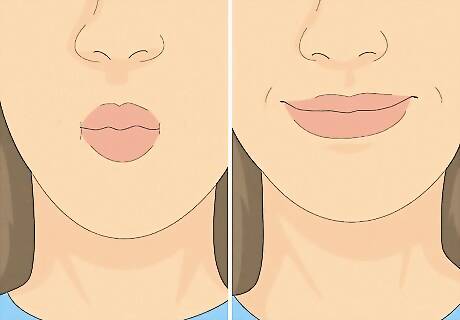
Increase your flexibility and control. Once you've practiced stretching and toning your facial muscles, you may want to work on gaining further control of your smile. One way to do this is by working other facial muscles while practicing your smile. Stretch the corners of your mouth outward as far as possible while keeping your lips closed. While holding that pose, try to wiggle your nose until you feel your cheek muscles begin to strain. Hold that pose for five seconds, then release. Repeat this exercise up to 10 times daily to develop a greater command over your facial muscles.
Smiling with Your Eyes
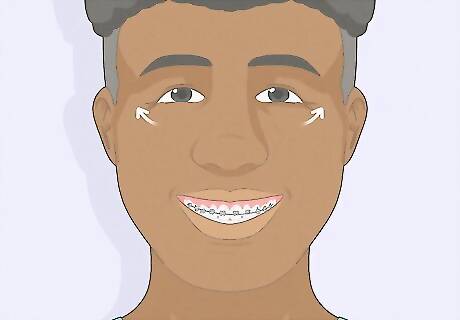
Smile until your eyes narrow. Psychologists have found that all sincere smiles involve the muscles around the eyes. Sometimes called the "Duchenne smile," this expression of sincere happiness causes so-called "crow's feet" creases around the eyes, as the eyes narrow and the smile broadens. It's a mechanism most people aren't consciously aware of, but with practice you can learn to smile with your eyes, giving you a more natural, sincere smile. Stand or sit in front of a mirror. Smile until you notice your eyes narrow slightly. Try to hold this pose and study the way your facial muscles stretch in this position. Practice smiling with your eyes until you're able to achieve this expression on command.

Replicate other Duchenne smiles. One way to practice smiling with your eyes is to look at photographs of other people exhibiting Duchenne smiles, then try to perform the same expression. You can easily find pictures online by searching for "Duchenne smile", and researchers have found that viewing a photograph of a Duchenne smile makes it easier to replicate that smile on command. Practice in front of a mirror or camera. Continue looking at Duchenne smiles and then practicing your own until you're able to smile with your eyes on command.

Try role-playing smiles. Research suggests that some people are capable of achieving a Duchenne smile while imagining (or "roleplaying") certain events that were causes of happiness. Imagining or remembering a fun occasion with friends, greeting a friend, and receiving a good grade were all scenarios that caused some people to express a Duchenne smile.
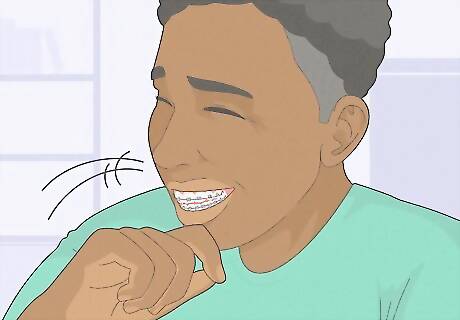
Try laughing to smile. Some research connects laughter with a Duchenne smile. If you're having trouble replicating the Duchenne smile on command, you may want to try forcing a brief instance of laughter to form a Duchenne smile. Think about something that amuses you or brings you joy, and practice laughing/smiling in front of a mirror.
Building Your Self-Esteem
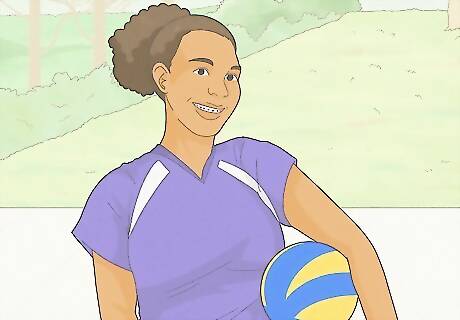
Focus on your strengths. Some researchers have found that actively thinking about your strengths and positive characteristics can help build a stronger self-esteem. Having a stronger sense of self may help you feel more comfortable with your new braces, and may make it easier to smile and feel confident.

Try repeating positive affirmations. Having one or more daily affirmations may help empower you and make you feel more confident and sure of yourself. You can use tried and true affirmations, such as "I am a valuable, compassionate person" and "I feel positive and loving toward myself." Or you can create your own affirmations related to having braces, such as "I know that I have a beautiful smile; it will only be better because of my braces."

Challenge your negative thoughts. It's common for everyone to have negative or self-doubting thoughts from time to time, but it's important to always remember that these thoughts are not who we really are. Any time you find yourself thinking negative thoughts about your braces or how they look, stop that thought pattern in its tracks and remind yourself that your braces won't be on forever, and you'll have a flawless smile when you're finished.
Taking Care of Your Smile
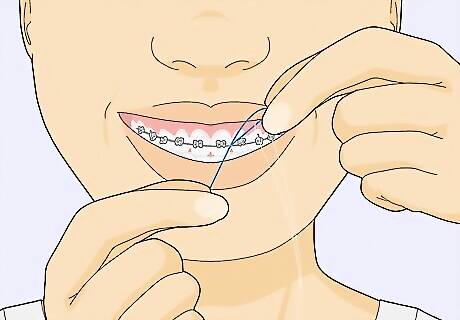
Buy dental floss with a threader. Some people with braces may feel uncomfortable smiling out of fear that there is something stuck between their teeth or braces. Flossing and taking special care of your teeth and braces can help remove that fear, giving you a confident, clean smile. It's important to floss, but some people with braces may find it difficult to work around the wires and brackets. Most makers of dental floss now offer floss with a stiff, straight end, called a threader, which can make it drastically easier to floss between your braces and gums. Look for floss threaders at your local pharmacy or grocery store. If you cannot find pieces of floss with their own threaders, you can also buy a threader that can be used with ordinary dental floss to accomplish the same task. For this type of threader, use about 12 inches of dental floss to ensure that you can adequately feed the floss through your teeth. There are also individual strands of floss that are stiffer and can be used along with braces to facilitate the cleaning. Work the floss in a c-shape. As you floss, try to form a c-shape against each tooth. Then work the floss up and down, scraping the sides of your teeth from every angle. This will help maximize the area covered by the dental floss. Floss after every meal to help keep a clean, bright smile.
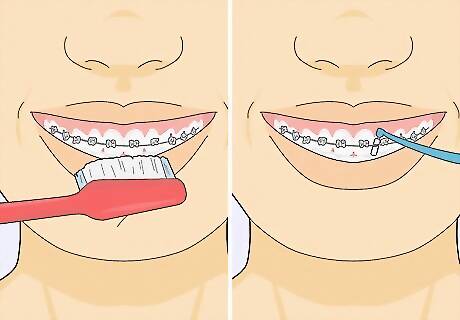
Brush your teeth. It's important to brush at least twice a day, but many dentists recommend patients with braces brush after every meal. In addition to your usual brushing routine, it's important to remember to brush around each and every part of your braces. Consider using an interproximal brush. It's a special brush built for people with braces that can easily slip underneath the wire of the braces.

Use an antiseptic mouthwash. Mouthwash can be used at home or on the go, especially after meals. Mouthwash helps mask bad breath and may help kill or remove harmful bacteria that cause unpleasant odors. Use the cap of the mouthwash bottle to pour out a "serving" of mouthwash. Pour the mouthwash into your mouth, but do not swallow. Rinse vigorously, focusing on each quadrant of your mouth. If at all possible, try to avoid rinsing with water immediately after rinsing with mouthwash. Mouthwash will continue to kill bacteria in your mouth after you've finished rinsing with it, and rinsing with water too soon after you've used mouthwash may disrupt this process.

Limit hard foods. Not only can hard foods lead to chipping or cracking of your teeth, but they're also prone to getting stuck underneath or between your braces. For this reason, it may be helpful to cut or break hard foods into smaller pieces before chewing.
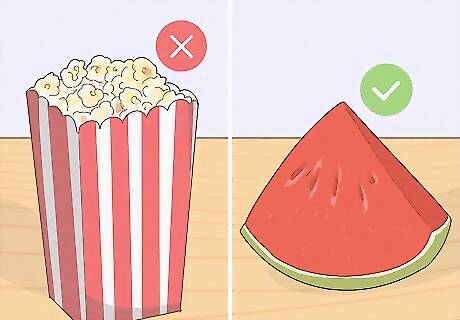
Avoid chewy and crunchy foods. Foods like popcorn, hard candies, and licorice can easily get stuck in your braces, and could even cause damage to your braces. Stick with softer foods, including fruits and vegetables, to ensure your smile is in good shape.

Cut out candy and sweets. Sugary foods are known to cause acidic deposits in teeth, and can lead to bad breath, decalcification of teeth, and even tooth decay. Hard candy can also damage your braces. Try to avoid candy and sweets as much as possible to have a healthy, fuller smile.


















Comments
0 comment